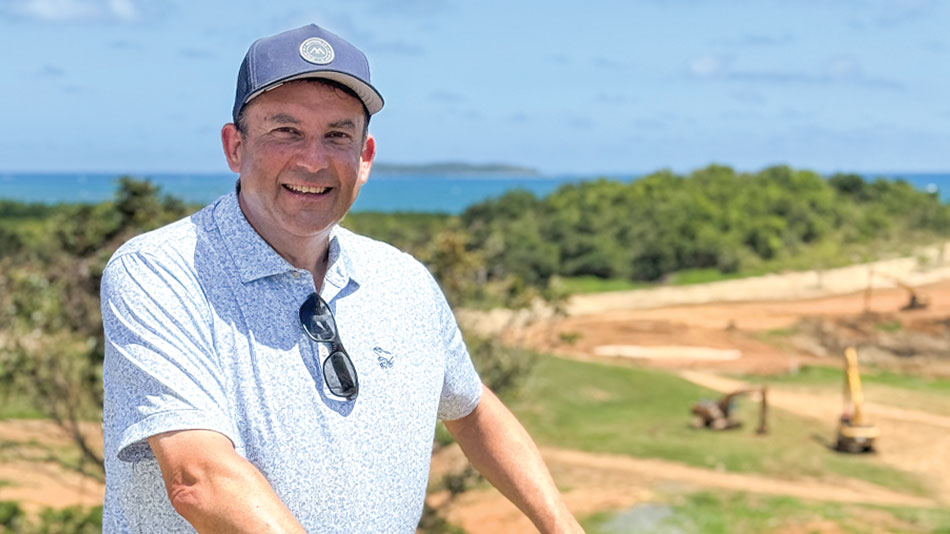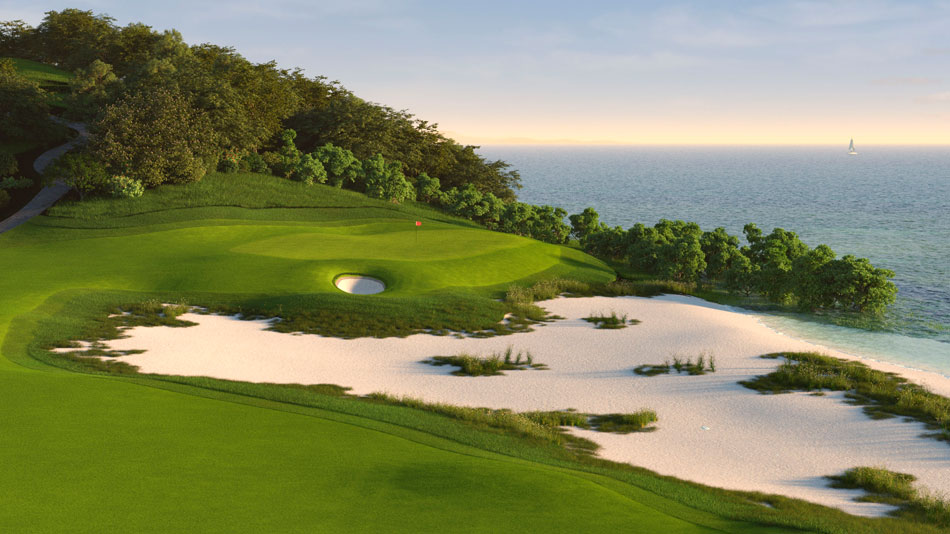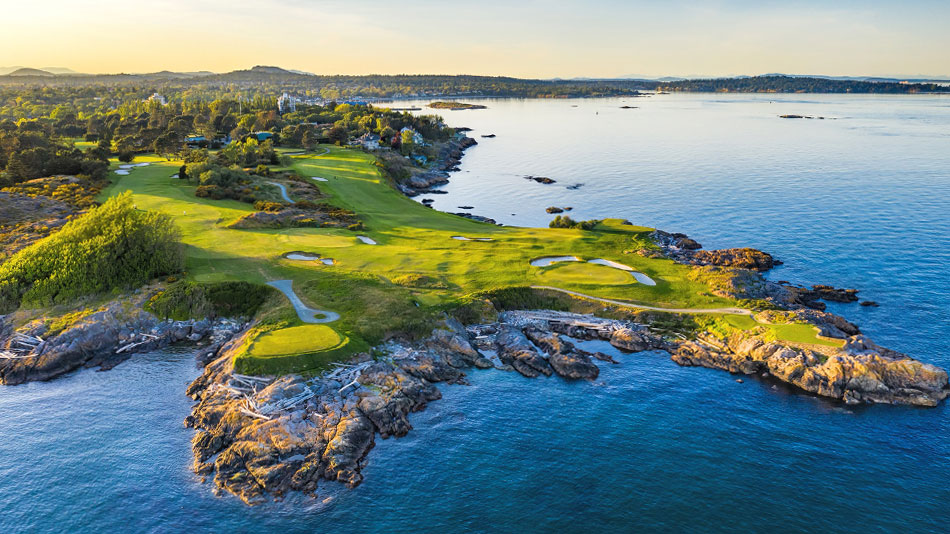Martin Ebert: Design journey
Twice a Cambridge golf Blue. Recruited by famed golf writer and architect Donald Steel to work in his booming design business. A long-time R&A member. It is easy to look at Martin Ebert’s CV and conclude he must be some sort of scion of the British ruling classes.
But his background is in fact significantly more normal: he discovered golf by watching tournaments on television.
“Maybe it was the sight of Augusta that really sparked my interest,” he says. His parents, neither of whom played golf, bought him a second-hand mixed bag of clubs for £10. “Mum would drop me at the Colnbrook driving range near Heathrow – an airport that is now my second home – where I hit balls for hours on end.
“My first forays onto a course were at Sandown Park on the par-three course in the middle of the racecourse. As my family did not play, I caddied for a lovely man called Maurice Curtis at Ashford Manor Golf Club for around a year after which he was happy to vouch for me and I was allowed to join the club as a junior where days of 54 holes in the summer holidays were the norm.”
Ebert attended Cambridge University – he is rather modest about this, but we should note that less than one per cent of Britons attend the two ancient universities, and the selection process is, to say the least, rigorous. “I was tempted into taking a shot in the golf trial after seeing the golf club’s incredible fixture list,” he explains. “A disastrous score at Gog Magog – where I now advise – meant that golf went nowhere until the following year when I managed an outward 35 in dense fog at Royal Worlington and a total score of 76 (a poor back nine after the fog lifted!). The trial score got me into the Stymies second team. That year of golf was great fun, culminating in a victory over the Oxford Divots at Southport & Ainsdale. The next year, I was promoted to the Blues team and played in two Varsity matches, at Royal Porthcawl and Rye, the latter of which was the hundredth match. We won both. To celebrate, we thought we should relive Henry Longhurst’s famous 1930 tour to the United States. I was the captain of the tour, and the engineering took a back seat as it was a full year of organisation. We played at Pine Valley, Merion, Shinnecock, The National Golf Links, Garden City, Maidstone, The Country Club, Sleepy Hollow, Yale, Winged Foot, The Creek, Baltusrol and Stanwich. It was a tremendous experience and left me wanting to make some sort of a career in golf rather than engineering, banking or management consultancy. However, I did not think that golf course design would be a possibility. I was not getting anywhere with my golfing job applications so thought I would train as an accountant and then get into golf that way, but then Donald Steel saved me from that fate!”
Also a Cambridge man, Donald Steel became the Sunday Telegraph’s golf correspondent in 1960, a role he would hold for 30 years. In 1965, he became a consultant to the golf architecture firm of Cotton, Pennink, Lawrie and Partners; after the deaths of the other partners, he founded Donald Steel & Co. Given that he was rather busy in the booming golf market of the day, he needed help. Steel hired Tom Mackenzie in 1989, and Ebert a year later. “Although I knew of Donald while playing university golf, I did not meet him then,” says Ebert. “I did make contact to see if he would write an article for our tour brochure, but we only met when Tom’s brother, Andy, who I played with on the team, suggested that I get in touch with Donald and Tom as they were very busy. I knew Donald more as a writer, so I did not know if the position was in relation to his writing or designing. I am glad that it turned out to be the latter!”
Steel was nominated to serve as president of the English Golf Union for 2006. He would be 68 on taking office and decided this was a good time to retire from the design business, so he closed his firm down, which left Ebert and Mackenzie with a decision to make. They decided to continue working together, but now as partners rather than employees, and founded Mackenzie & Ebert (M&E) in 2005. “Starting our own firm seemed to be the natural thing to do,” says Ebert. “We were also getting into a more technical way of designing, with AutoCAD providing the perfect tool for our plans. We had our very talented colleague, Chris Huggett, who had worked for Donald since 2000, to really push on with the advances on that front. We were very nervous about how things would go with the golf design business being so name-oriented; losing Donald’s was a concern. However, we did inherit the vast majority of the projects of the old company and the business was still buoyant in the first three years. Then the ‘crash’ happened, and we were not certain where the next project would come from. The new course market collapsed. With Donald, we were designing perhaps three or four new courses a year. That dried up almost completely. We had to rely on developing our existing course portfolio and that gradually happened as the world got back on its feet and clubs started to look to improve their courses.
“We were already working on improvements to Turnberry during the changeover of companies to get it ready for the Open in 2009 so that was helpful in establishing our reputation. The first Open venue that commissioned us was Royal Lytham & St Annes: we pulled out all the stops to secure that one. Royal St George’s wanted to look to see who they would use, and we had to prove ourselves all over again despite working for the club with Donald. Gradually, we grew the Open advice to eight of the ten Open venues.
“Internationally, implementing the new course I designed with Donald at Goodwood, on a beautiful site to the north of Toronto, was important. Hirono (pictured on page 42) came later and signalled that our boundaries were pushing further and further away from home.”
The enormous success of M&E means that the firm has expanded to include two other designers, Mike Howard and Greg Smeaton, and two ‘architectural visualisers’, Patrick Roseveare and Cam Main (M&E produces its own CGI stills and videos). Chris Huggett now serves as chief operating officer. This makes it, along with European Golf Design, pretty much the largest design firm in Europe, and figuring out who works on each job must be a major challenge. “In many cases, there is a natural connection to either Tom or me when new opportunities arise – some through contacts we each have and some through where we are already working,” says Ebert. “Workload is also a consideration as, on occasions, one of us has more capacity to make a visit than the other. As a result of our detailed plans, we can take on a lot of projects and still serve them comprehensively to produce the highest quality results. We make numerous visits during projects (as an example, I went to Hirono 13 times in ten months during that project), but the shapers and contractors know what is required when we are not on site as a result of our plans and on-site direction. Now, as a result of Covid, when we had to support the major Hamilton renovation project in Canada without visiting the club once, we have techniques to support construction remotely. Drone surveying of construction areas, 3D photos and videos viewed with virtual reality headsets and Photoshopping sand lines on 2D photos are now great tools of our trade.
“In addition, we have our in-house produced CGI stills and videos of our proposals to assist us with evaluating our designs and to help the shapers in understanding what we want to achieve. Our true-to-life imagery helps to convince members that our proposals are in their best interests, and provides impressive marketing materials. However, it is only possible to produce that by drawing highly accurate plans of our proposals so that a 3D model of the proposed course or holes can be produced.”
This talk of plans leads to an important differentiation between M&E and some of its peers, As is well known, some of the most successful designers in the business – headed by, but not limited to, Coore and Crenshaw, Tom Doak and Gil Hanse – are not great fans of detailed plans, preferring to control construction through using shapers they directly employ, and making design decisions in the field. M&E comes from a different background, creating extremely detailed plans of all jobs, and not having a construction operation of their own. “We regularly hear the views of other designers and also architectural commentators that the best golf courses can only be built in the field and that plans should be torn up as soon as permission is obtained,” says Ebert. “We recently came across a video where a designer said, ‘you show me a course built to a plan, and I will show you a bad golf course’. We do not say that you cannot build a great course without plans. The designers who work that way have produced some amazing courses themselves and often trust their design associates and shapers to produce the goods. However, we think that we prove that you can build great courses and great holes with plans.”
Ebert says that the greater proliferation of high-quality designer/shapers in the American market probably makes the design-and-shape model easier to execute for firms based there.
“There are more independent shapers in the US and that certainly helps with building without a detailed plan,” he says. “In the UK, almost all projects are tendered, so clients and contractors need an accurate representation of what is required. That can only be delivered through the preparation of an accurate set of plans. But plans must be supplemented with sufficient visits and construction support.
“Without plans, there is a real danger that greens, in particular, get out of control in terms of their levels. It is all too easy for the vertical scale of green surfaces to be exaggerated to the point that an individual green, or a set of 18 greens, really lets the course down. While the best courses have a great set of greens, providing challenge, variety and beauty, the golfer should not come away from a green or a course feeling as though the putting test is absurd. I believe that is happening more and more due to a lack of control of the named designer, with them being so busy and unable to visit sites to provide their critical on-site input sufficiently. We can judge our individual greens and a set of 18 before any construction starts, analysing the slopes to identify where flag positions will exist and to judge the slopes between those areas.”
M&E’s ubiquity on the Open Championship rota – where courses, like it or not, have needed to be made longer and more difficult to deal with the enormous distances players now hit the ball – has perhaps fed through to some of its work on other historic courses. The firm is known for updating these courses, as well as doing some highly acclaimed restorative work: its projects have rarely been purely restorative. “Hirono provides a great example,” says Ebert. “The club wanted to restore the character of Hugh Alison’s design which very much focused on restoring the incredibly intricately shaped bunkers, although I think that these were actually produced after the course was first opened and are quite different to the shapes shown on Alison’s plans. Anyway, while our advice was to restore many of the old bunkers, even though they were more visually important than relevant to the modern game, we also said that some new bunkers were needed to make sure that the elite level players have to think as much as they used to. So yes, we do update courses, but we also restore where it makes sense from an aesthetic and/or playing point of view. There has most certainly been a need to update our Open venues if they are to remain a searching test of the best players in the world, given the way that the game is now played.”
Another criticism that has been directed the firm’s way is a direct consequence of its huge success on the British and Irish links courses. Has the success of one design firm in this space led to a degree of similarity developing across courses that were previously more diverse? In particular, the spread of exposed sand areas – which are unarguably both historically representative of how links used to look, and have extremely high ecological value, as habitat for plants and animals – has been suggested as a sign of the over-dominance of M&E.
Ebert says he is conscious of this thought. “We like to think that we are not arrogant which would lead to thinking that we get everything right but, at the same time, we must be doing something right and sometimes adverse comment comes as a result of success,” he says. “Sand scrapes are an interesting subject. Historical research shows us that all of our links courses used to enjoy a much sandier landscape. They have all grown over as time has passed. Is it the right thing to restore that landscape? Not everyone likes the look and some of our clients do not and hence we do not restore these features if the club is not persuaded by the reasons for them. However, the ecological argument to produce more sand on links courses is a powerful one, with many case studies illustrating the tremendous benefits to both flora and fauna. Where else might any designer exhibit ‘sameness’? Green design, including the all important approaches and surrounds, is a key aspect of our creativity where maybe we might exhibit a certain theme of design characteristics. All I can say on that matter is that we are so fortunate to play, view, work on and study many of the courses designed by the great Golden Age architects. We think that feeds through to our own green designs and every green we do design is started from scratch. There are no templates in our office!”
This article first appeared in the April 2025 issue of Golf Course Architecture. For a printed subscription or free digital edition, please visit our subscriptions page.
| Slideshow HTML |
-

Taku Miyamoto
Martin Ebert, principal of the Mackenzie & Ebert design firm, on site at Hirono in Japan
-

Mackenzie & Ebert
Martin frequently uses a bicycle to make his way around site, as pictured at Moncayo in Puerto Rico
-

Mackenzie & Ebert
A visualisation that Mackenzie & Ebert produced in-house of the fifteenth hole at Moncayo
-

Victoria Golf Club
Victoria GC on Vancouver Island, Canada, appointed Mackenzie & Ebert to produce a masterplan in 2024. The details of the proposals are now being drawn up
-

David Cannon
Mackenzie & Ebert has continued to advise Royal Portrush following work completed ahead of the 2019 Open, which included the creation of ‘Dunluce’, the new par-four eighth
|
| ADd Image Credit here for home page | Taku Miyamoto |